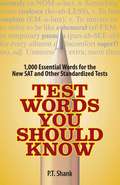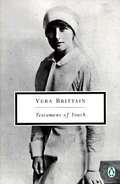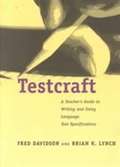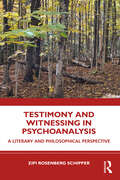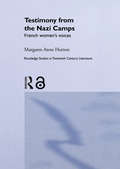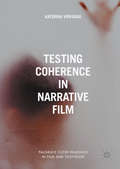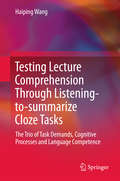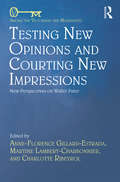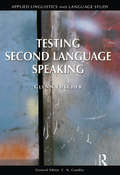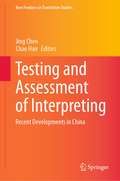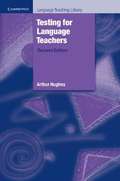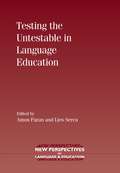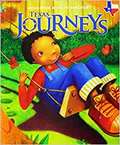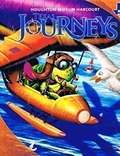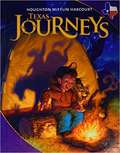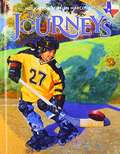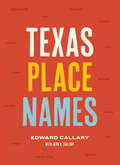- Table View
- List View
Test Words You Should Know: 1,000 Essential Words for the New SAT and Other Standardized Texts
by P. T. ShankTest Words You Should Know features 1,000 useful words and definitions that you should not be without. No matter which standardized test you're preparing for, you can ace it with confidence once you have these essential words under your belt. Each entry features a word, a definition and an example showing the word used properly in a sentence. 228 pages with a word list.
Testament to Youth: An Autobiographical Study of the Years 1900-1925
by Vera BrittainIn 1915, the author enlisted as a nurse in the armed services. She explores the politics and hopes of those people who came of age as war broke out.
Testcraft: A Teacher's Guide to Writing and Using Language Test Specifications
by Fred Davidson Brian K. LynchTestcraft is a book about language test development using test specifications, which are generative blueprints for test design. It is intended for language teachers at all career levels, from those in degree or training programs to those who are working in language education settings.
Testimony and Witnessing in Psychoanalysis: A Literary and Philosophical Perspective
by Zipi Rosenberg SchipperIn this fascinating volume, Zipi Rosenberg Schipper approaches the fundamental topic of testimony, seeking to recognize its value as a distinct and vital function in psychoanalytic work, separate from its inherited importance to work on trauma. Rosenberg Schipper introduces a revivifying philosophical, linguistic and psychoanalytic approach to the act of testimony, focusing on the role of witnessing in daily life and the importance it has as a therapeutic tool in psychoanalytic and psychological therapy. Throughout, she pinpoints three key psychoanalytic theories on patient testimony. She begins by looking at Freud’s foundational work on testimony as a means of concealing the unconscious and the questions of credibility in the consulting room this creates before looking at Winnicottian and Kohutian theories, whereby therapists take everything the patient says as a definitive truth. She concludes by looking at the Intersubjective and Relational schools of thought, where the therapist assumes the role of witness. By providing a comprehensive overview of the conflicting theories on the topic, Rosenberg Schipper equips practicing psychoanalysts and analysts-in-training with the tools necessary to utilize this vital therapeutic device and engage with it in treatment for all patients.
Testimony from the Nazi Camps: French Women's Voices (Routledge Studies in Twentieth-Century Literature)
by Margaret Anne HuttonThis interdisciplinary study intergrates historiographical, literary and cultural methodologies in its focus on a little known corpus of testimonial accounts published by French women deported to Nazi camps. Comprising epistemological and literary analyses of the accounts and an examination of the construction of deportee identities, it will interest those working in the fields of modern French literature, genre, women's studies and the Holocaust.
Testimony on Trial
by Brian ArteseWho is a more authoritative source of information -- the person who experiences it firsthand, or a more 'impartial' authority? In the late nineteenth century, testimony became a common feature of literary works both fact and fiction. But with the rise of new journalism, the power of testimony could be undermined by anonymous, institutional voices -- a Victorian subversion which continues to this day. Testimony on Trial examines the conflicts over testimony through the eyes of two of its major combatants, Joseph Conrad and Henry James. Brian Artese finds an overlooked yet direct inspiration for Heart of Darkness in the anti-testimonial scheming of Henry Morton Stanley and the New York Herald. Through new readings of works including Lord Jim and The Portrait of a Lady, Artese demonstrates how the cultural conditions that worked against testimony fed into a nascent conflict about the meaning of modernism itself.
Testing Coherence in Narrative Film
by Katerina VirvidakiThis book examines the concept of coherence in film studies. It asks if there are ways to appreciate the achievement of coherence in narrative films that are characterised by an eccentric or difficult style, as well as by an apparently confusing intelligibility. In order to answer this critical question, the author argues that we need to reconsider the predominant understanding of the concept of coherence in film studies. Virvidaki identifies how a general function of coherence is manifested through the aesthetic of transparency and unobtrusiveness of classical Hollywood film. The author then proceeds to a close analysis of stylistically perplexing narrative films, in order to demonstrate how we can broaden, expand and readjust the classical criteria of coherence. Testing Coherence in Narrative Film will appeal to film and philosophy scholars interested in aesthetics and narrative form.
Testing Lecture Comprehension Through Listening-to-summarize Cloze Tasks: The Trio of Task Demands, Cognitive Processes and Language Competence
by Haiping WangThis book explores the effectiveness of listen-to-summarize tasks as a tool to assess lecture comprehension ability. It especially focuses on listen-to-summarize tasks that represent listeners’ meaning building and the discourse construction of the lecture for listening assessment purposes. It discusses in depth the nature of lecture comprehension and introduces the approaches to assessing it. It also presents teachers’ and students’ perceptions of listen-to-summarize task demands and their respective implications. By observing interactions between test-takers’ cognitive processes and the task itself, the book explores the effectiveness of these tasks. It also examines the discrepancy in cognitive processes between different language competence levels in detail, shedding light upon current research on lecture comprehension assessment and offering insights into listening comprehension instruction.
Testing New Opinions and Courting New Impressions: New Perspectives on Walter Pater (Among the Victorians and Modernists)
by Anne-Florence Gillard-Estrada Martine Lambert-Charbonnier Charlotte RibeyrolReflecting Walter Pater’s diverse engagements with literature, the visual arts, history, and philosophy, this collection of essays explores new interdisciplinary perspectives engaging readers and scholars alike to revisit methodologies, intertextualities, metaphysical positions, and stylistic features in the works of the Victorian essayist. A revised contextual portrait of Pater in Victorian culture questions representations of the detached aesthete. Current editorial and biographical projects show Pater as fully responsive to the emergence of modern consumer culture and the changes in readership in Britain and the United States. New critical views of rarely studied texts enhance the image of Pater as a cosmopolitan aesthete dialoguing with contemporary culture. Conceptual analysis of his texts brings new light to the aesthetic paradox embodied by Pater, between artistic detachment and immersion in the Heraclitean flux of life. Finally, aestheticism is redefined as proposing new artistic and linguistic synthesis by merging art forms and embracing interart poetics.
Testing Second Language Speaking (Applied Linguistics and Language Study)
by Glenn FulcherThe testing and assessment of second language learners is an essential part of the language learning process. Glenn Fulcher's Testing Second Language Speaking is a state-of-the-art volume that considers the assessment of speaking from historical, theoretical and practical perspectives.The book offers the first systematic, comprehensive and up-to-date treatment of the testing of second language speaking. Written in a clear and accessible manner, it covers: Explanations of the process of test design Costing test design projects How to put the test into practice Evaluation of speaking tests Task types for testing speaking Testing learners with disabilities It also contains a wealth of examples, including task types that are commonly used in speaking tests, approaches to researching speaking tests and specific methodologies that teachers, students and test developers may use in their own projects. Successfully integrating practice and theory, this book demystifies the process of testing speaking and provides a thorough treatment of the key ethical and technical issues in speaking evaluation.
Testing and Assessment of Interpreting: Recent Developments in China (New Frontiers in Translation Studies)
by Jing Chen Chao HanThis book highlights reliable, valid and practical testing and assessment of interpreting, presenting important developments in China, where testing and assessment have long been a major concern for interpreting educators and researchers, but have remained largely under-reported. The book not only offers theoretical insights into potential issues and problems undermining interpreting assessment, but also describes useful measurement models to address such concerns. Showcasing the latest Chinese research to create rubrics-referenced rating scales, enhance formative assessment practice, and explore (semi-)automated assessment, the book is a valuable resource for educators, trainers and researchers, enabling to gain a better understanding of interpreting testing and assessment as both a worthwhile endeavor and a promising research area.
Testing for Language Teachers
by Arthur HughesThis second edition remains the most practical guide for teachers who want to have a better understanding of the role of testing in language teaching. It has a new chapter on testing young learners and expanded chapters on common test techniques and testing overall ability.
Testing the Untestable in Language Education
by Amos Paran Lies SercuThe testing and assessment of language competence continues to be a much debated issue in foreign language teaching and research. This book is the first one to address the testing of four important dimensions of foreign language education which have been left largely unconsidered: learner autonomy, intercultural competence, literature and literary competence, and the integration of content and language learning. Each area is considered through a theoretical framework, followed by two empirical studies, raising questions of importance to all language teachers: How can one test literary competence? Can intercultural competence be measured? What about the integrated assessment of content-and-language in CLIL and teaching? Is progress in autonomous learning skill gaugeable? The book constitutes essential reading for anyone interested in the testing and assessment of seemingly largely untestable aspects of foreign language competence.
Texas Assessment Preparation [Grade 3] (Into Reading)
by Houghton Mifflin Harcourt Publishing CompanyNIMAC-sourced textbook
Texas Assessment Preparation [Grade 4]
by Houghton Mifflin Harcourt Publishing CompanyNIMAC-sourced textbook
Texas Assessment Preparation [Grade 7] (Into Reading)
by Houghton Mifflin Harcourt Publishing CompanyNIMAC-sourced textbook
Texas Assessment Preparation [Grade 8] (Into Reading)
by Houghton Mifflin Harcourt Publishing CompanyNIMAC-sourced textbook
Texas Journeys (Grade 2, Level 2.1)
by The Editors at the Houghton Mifflin HarcourtYou are about to begin a journey into reading. Along the way you will meet many new characters, such as a superhero dog. You'll also travel to the world of outer space and other exciting places.
Texas Journeys (Grade 2, Level 2.2)
by The Editors at the Houghton Mifflin HarcourtYou're about to set out on a reading journey.On the way, you'll learn amazing things as you become a better reader.
Texas Journeys (Grade 3 Level 3.1)
by The Editors at the Houghton Mifflin HarcourtYou're about to set out on a reading journey that will take you from the streets of Japan to a fossil field in Canada, bursting with dinosaur bones! On the way, you'll learn amazing things as you become a better reader.
Texas Journeys Grade 5
by Houghton Mifflin HarcourtWhen you just turn the pages of the book, plenty of other reading adventures lie ahead that will take you from a virtual ride on a space shuttle to the countryside of Spain, where a knight battles a windmill. On the way, you will learn amazing things as you become a better reader.
Texas Place Names
by Edward Callary Jean K. Callary&“[A] linguist . . . takes readers on a tour across the state, using names and language to tell its history.&” ―Alcalde Was Gasoline, Texas, named in honor of a gas station? Nope, but the name does honor the town&’s original claim to fame: a gasoline-powered cotton gin. Is Paris, Texas, a reference to Paris, France? Yes: Thomas Poteet, who donated land for the town site, thought it would be an improvement over &“Pin Hook,&” the original name of the Lamar County seat. Ding Dong&’s story has a nice ring to it; the name was derived from two store owners named Bell, who lived in Bell County, of course. Tracing the turning points, fascinating characters, and cultural crossroads that shaped Texas history, Texas Place Names provides the colorful stories behind these and more than three thousand other county, city, and community names. Drawing on in-depth research to present the facts behind the folklore, linguist Edward Callary also clarifies pronunciations (it&’s NAY-chis for Neches, referring to a Caddoan people whose name was attached to the Neches River during a Spanish expedition). A great resource for road trippers and historians alike, Texas Place Names alphabetically charts centuries of humanity through the enduring words (and, occasionally, the fateful spelling gaffes) left behind by men and women from all walks of life. &“[A] quite useful book.&” ―Austin American-Statesman
